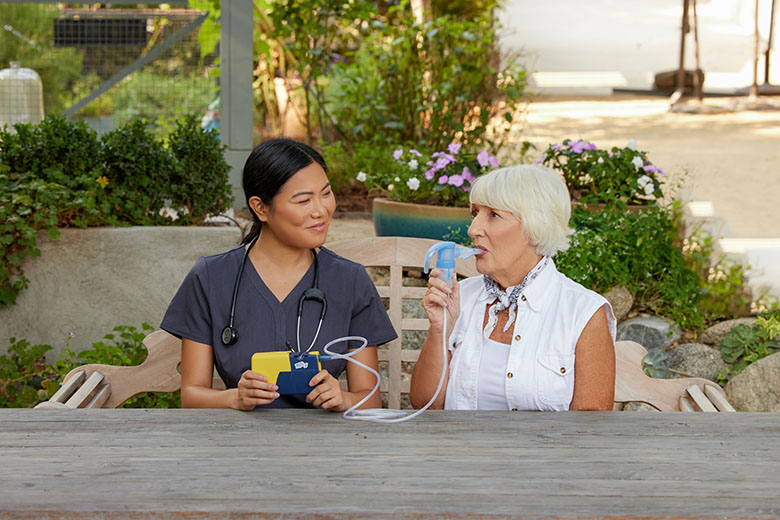Whether you have chronic obstructive pulmonary disease, emphysema, chronic bronchitis, asthma, or another respiratory condition, nebulizers are an effective way to administer respiratory medications. Continue reading to understand the basics of nebulizer therapy and how it can be done safely and effectively at home.
What is a nebulizer?
A nebulizer is a medical device used to deliver drugs directly into your lungs by turning liquid medicine into a mist. Administering medication as a mist enables it to enter your respiratory system more quickly and easily. Nebulizers deliver the same type of drug as inhalers and are especially useful because they are simple to use. Nebulizer treatment provides fast relief when you are experiencing symptoms such as shortness of breath, chronic cough, and excess mucus caused by any of the following: chronic obstructive pulmonary disease, emphysema, chronic bronchitis, asthma, or another respiratory condition.
Lincare offers various options for both stationary and portable nebulizers. Each features an air compressor and tubing that connects to the nebulizer cup. These devices also have a mouthpiece or mask through which you inhale the medication.
How to use a nebulizer compressor
Every nebulizer compressor is slightly different, so it is important to read the manufacturer's instructions for your specific device before using it. Please take special note of any safety precautions mentioned in the directions and put them in a safe place if you need them for reference. For stationary nebulizers and portable nebulizer compressors, begin by placing the compressor on a flat, stable, and dust-free surface and plug it into an outlet. Follow these steps:
- Wash your hands thoroughly. Gather your supplies: nebulizer cup, mouthpiece/mask, reservoir tube (if applicable), and tubing.
- Attach one end of the tubing into the air outlet on the compressor.
- Attach the other end of the tubing to the nebulizer cup. Attach the T-piece and mouthpiece or mask to the nebulizer cup.
- Twist the end of the unit-dose medication vial. Squeeze all the liquid medication into the nebulizer cup.
- Turn on the compressor. You should see an aerosol mist coming from the mouthpiece or mask.
- Sit in an upright position. Take normal breaths during your treatment. If you feel lightheaded or dizzy, you may be breathing too quickly. STOP your treatment, relax until the feeling subsides, and then finish the rest of the treatment. If your heart starts racing during treatment, STOP and call your practitioner.
- Use all the medicine in the nebulizer cup with each treatment.
- Clean your nebulizer cup with warm, soapy water after every use and allow it to air dry.
- Store the medication in the container it came in and place it out of reach of children. Store at room temperature in a cool place.
- For portable nebulizer compressors, ensure the battery is charged prior to use.
Nebulizer compressor guidelines
As with any medical treatment, understanding how to use a nebulizer compressor properly is important. Be sure to follow these guidelines to be safe and get the most out of your therapy:
- Always follow your practitioner's prescription.
- Be sure to clean your nebulizer compressor and supplies after each use. If proper care is not taken, there may be an increased risk for bacteria to grow, which could increase the risk for infection.
- Store your nebulizer supplies in a sealed plastic bag to keep them clean.
- Follow the storage instructions for the medication. Do not use medications that have reached their expiration date.
Conclusion
Home nebulizers can be a very effective way of delivering medication, especially for people who have difficulty using inhalers. The key is to use the nebulizer compressor properly. It is important to work with your practitioner to determine the best type of nebulizer and medication to use and how often to use it.



